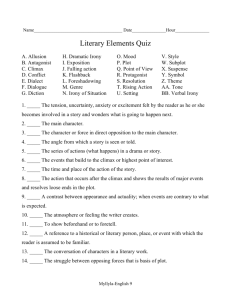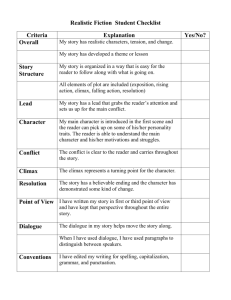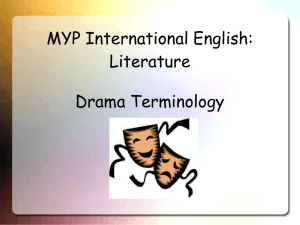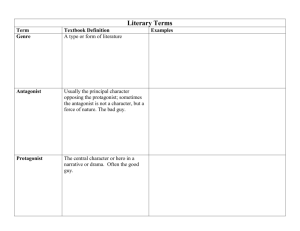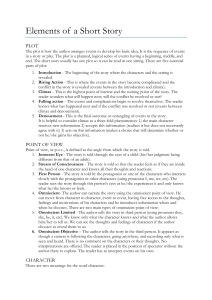Elements of the Short Story
advertisement
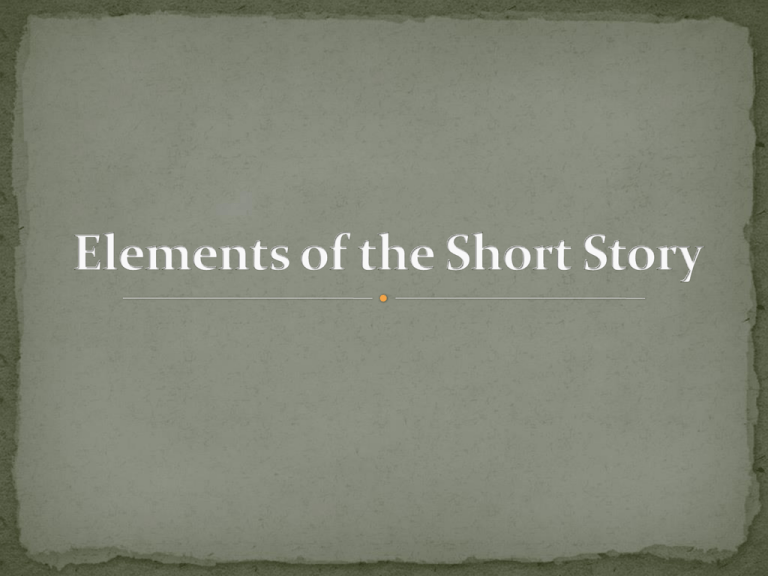
“A story is only as strong as the voices telling it… The only voice a story never needs is the author’s . Characters need to speak for themselves in their own distinct voices… Particularly in a short story, every word they speak needs to sounds like the speaker and move the story along.” - Richard Peck (1936-) The angle or perspective from which the story is told Who is telling the story? For instance, is it a player on the home team or someone watching the game? How do we know what is happening? For instance, does a character tell us? Told from the viewpoint of one of the characters, using the first person pronoun “I”. Innocent Eye: The story is told through the eyes of a child (his/her judgment being different from that of an adult). Stream of Consciousness: The story is told so that the reader feels as if they are inside the head of one character and knows all their thoughts and reactions. “The thousands of injuries of Fortunato I had borne as I best could, but when he ventured upon insult I vowed revenge. You, who so well know the nature of my soul, will not suppose, however, that I give utterance to a threat.” “The Cask of Amontillado” by Edgar Allan Poe The story is told using a narrator who is located outside of the action of the story and uses third person pronouns such as “he”, “she”, “his”, “her”, “they” etc. Third Person Point of View can be broken up into three different types: Omniscient Limited Omniscient Objective The narrator has the power to show the reader what is happening though a number of characters’ eyes. “Myop carried a short knobby stick. She struck out at random at chickens she liked, and worked out the beat of a song on the fence around the pigpen. She felt light and good in the warm sun. She was ten, and nothing existed for her but her son, the stick she clutched in her dark brown hand, and the tat-de-ta-ta-ta of accompaniment.” “The Flowers” by Alice Walker Third person, told from the viewpoint of a character in the story. “They all laughed, and while they were laughing, the quiet boy moved his bare foot on the sidewalk and merely touched, brushed against a number of red ants that were scurrying about on the sidewalk. Secretly his eyes shining, while his parents chatted with the old man, he saw the ants hesitate, quiver, and lie still on the cement. He sensed they were cold now.” “Fever Dream” by Ray Bradbury Third person, told as if from a camera that follows the characters. Only what is said and done is recorded. The reader is never allowed into any of the characters’ minds, nor given any of their feelings or emotions. “The officers of artillery, in smart blue uniforms faced with black velvet and gold, were solidly banked across one end of the audience hall, with flashing new swords and their gilt-braided hats stiffly held under their arms. From the door of that chamber, around the gallery, down the state staircase, across the grandiose inner court of the palace, and out through the imposing gates to the street, stood a double line of soldiers, with their rifles at present arms. Four regimental bands grouped in one wedged in the crowd. The people of the capital were massed in solid thousands on the Plaza de Armas before the palace..” from Insurgent Mexico, by John Reed Characters can be: Human Animals Inanimate objects A short story only has room for a few characters 1) Direct Characterization: The author develops the personality of a character by direct statements. “Jack had been in basic training in Florida and Dottie was there on vacation with her parents. They’d met on the beach and struck up a conversation. Dottie was the talker, the outgoing one – the extrovert. Jack was too shy around girls to say much at all.” “Furlough – 1944” by Harry Mazer 2) Indirect Characterization: Revealing a character’s personality through: a) The character’s thoughts, words, and actions b) The comments of other characters c) The character’s physical appearance “Moonbeam closed his eyes and pretended to sleep the rest of the way to Bamfield. He couldn’t believe what he had gotten himself into. How had this happened? He’d never held a gun in his life, much less gone hunting for animals.” “Moonbeam Dawson and the Killer Bear” by Jean Okimoto It was Kenny Griffen, smiling complacently. “Miss Bird sent me after you ‘cause you been gone six years. You’re in trouble… yer constipated!” Kenny chortled gleefully. “Wait’ll I tell Caaathy!” “Here There Be Tygers” by Stephen King “The boy held his breath; he wondered whether his father would hear his heart beating… Through a crack in the counter he could see his father where he stood, one hand held to his high stiff collar…” “I Spy” by Graham Greene “Miss Kinney was young and blonde and bouncy and had a boyfriend who picked her up after school in a blue Camaro.” “Here There Be Tygers” by Stephen King The setting is the place and time where the story takes place. In a short story, the setting is often set in one central place and happens over a brief period of time. That evening T.J. smelled the air, his nostrils dilating with the odor of the earth under his feet. “It’s spring,” he said, and there was gladness rising in his voice that filled us all with the same feeling. “It’s mighty late for it, but it’s spring” … We were all sniffing at the air, too, trying to smell it the way that T.J. did, and I can still remember the sweet odor of the earth under our feet. It was the first time in my life that spring and spring earth had meant anything to me. “Antaeus” by Borden Deal “During the whole of a dull, dark, and soundless day in the autumn of the year, when the clouds hung oppressively low in the heavens, I had been passing alone, on horseback, though a singularly dreary tract of country.” “The Fall of the House of Usher” by Edgar Allan Poe Conflict is the dramatic struggle between two forces in a story. Without conflict there is no plot. Protagonist: The central character Antagonist: A villain or anyone who stands in the protagonist’s way and must be defeated. A short story can’t afford to have any subplots or sub-conflicts because it doesn’t have the space to develop them. It has one conflict that it follows through to the end. There are two types of conflict: 1) External - A struggle with a force outside one's self. 2) Internal - A struggle within one's self; a person must make some decision, overcome pain, quiet their temper, resist an urge, etc. There are four kinds of conflict: 1) Human vs. Human (physical) - The leading character struggles with his physical strength against other men, forces of nature, or animals. 2) Human vs. Circumstances (classical) - The leading character struggles against fate, or the circumstances of life facing him/her. 3) Human vs. Society (social) - The leading character struggles against ideas, practices, or customs of other people. 4) Human vs. Himself/Herself (psychological) - The leading character struggles with himself/herself; with his/her own soul, ideas of right or wrong, physical limitations, choices, etc. Plot is how the author arranges events to develop his/her basic idea. It is the sequence of events in a story or play. The plot is a planned, logical series of events having a beginning, middle and end. Introduction: The start of the story, the situation before the action starts Rising Action: The series of conflicts and crisis in the story that lead to the climax Climax / Turning Point: The most intense moment – either mentally or in action – the reader wonders what will happen next; will the conflict be resolved or not? Falling Action: The events and complications begin to resolve themselves. (The events between the climax and the resolution) Resolution: The untangling of events in the story Conclusion: Leaves the reader with a feeling of completion and satisfaction and in some cases brings the reader back to the beginning (full circle) The atmosphere or feeling in a work of fiction is its mood The writer creates the mood through setting, characters, and descriptive details Ex. funny, frightening, romantic, or adventurous Short stories usually only have one mood The theme of a short story is simply its meaning. It is the main idea explored in the story by the writer. It answers the question: What did you learn about the human condition or human nature? The writer can EXPLICITLY write about the theme through the story idea, or the writer can IMPLICTLY suggest the theme through the setting, plot, conflict, change in the mind or actions of the main character. Some techniques to use in narratives…. A lion can be A journey can a symbol of courage symbolize life A red rose Water may represent cleanliness and renewal can represent love This is a writers’ technique in which the author interrupts the plot of the story to recreate an incident of an earlier time (goes back in time; like giving the reader a memory). This device is often used to provide additional information to the reader. This is a writers’ technique in which the author provides clues or hints as to what is going to happen later in the story. It’s like the music in a scary movie when we know that something bad is about to happen.

